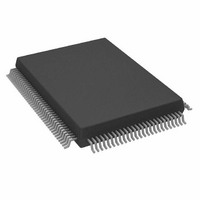AD9888KSZ-140 Analog Devices Inc, AD9888KSZ-140 Datasheet - Page 7

AD9888KSZ-140
Manufacturer Part Number
AD9888KSZ-140
Description
IC FLAT PANEL INTERFACE 128-MQFP
Manufacturer
Analog Devices Inc
Datasheet
1.AD9888KSZ-205.pdf
(32 pages)
Specifications of AD9888KSZ-140
Applications
Graphic Cards, VGA Interfaces
Interface
2-Wire Serial
Voltage - Supply
3 V ~ 3.6 V
Package / Case
128-MQFP, 128-PQFP
Mounting Type
Surface Mount
Supply Current
200mA
Power Dissipation Pd
850mW
Supply Voltage Range
3V To 3.6V, 2.2V To 3.6V
Digital Ic Case Style
MQFP
No. Of Pins
128
Operating Temperature Range
0°C To +70°C
Svhc
No SVHC
Number Of Elements
3
Resolution
8Bit
Sample Rate
140MSPS
Input Polarity
Bipolar
Input Type
Voltage
Rated Input Volt
±0.25/±0.5V
Differential Input
No
Power Supply Requirement
Single
Single Supply Voltage (typ)
3.3V
Single Supply Voltage (min)
3V
Single Supply Voltage (max)
3.6V
Dual Supply Voltage (typ)
Not RequiredV
Dual Supply Voltage (min)
Not RequiredV
Dual Supply Voltage (max)
Not RequiredV
Power Dissipation
1.05W
Differential Linearity Error
±1.35LSB
Integral Nonlinearity Error
±2.5LSB
Operating Temp Range
0C to 70C
Operating Temperature Classification
Commercial
Mounting
Surface Mount
Pin Count
128
Package Type
MQFP
Input Signal Type
Single-Ended
Interface Type
2-wire, Serial
Rohs Compliant
Yes
Lead Free Status / RoHS Status
Lead free / RoHS Compliant
Lead Free Status / RoHS Status
Lead free / RoHS Compliant, Lead free / RoHS Compliant
Available stocks
Company
Part Number
Manufacturer
Quantity
Price
Company:
Part Number:
AD9888KSZ-140
Manufacturer:
AD
Quantity:
217
Company:
Part Number:
AD9888KSZ-140
Manufacturer:
ADI
Quantity:
482
Company:
Part Number:
AD9888KSZ-140
Manufacturer:
Analog Devices Inc
Quantity:
10 000
Mnemonic
CKINV
Outputs
D
D
D
D
D
D
DATACK
DATACK
HSOUT
SOGOUT
REF BYPASS
RMIDSCV
BMIDSCV
REV. B
R
R
G
G
B
B
A
B
A
B
A
B
7–0
7–0
7–0
7–0
7–0
7–0
Description
Sampling Clock Inversion (Optional)
This pin may be used to invert the pixel sampling clock, which has the effect of shifting the sampling phase 180°.
This is in support of Alternate Pixel Sampling mode, wherein higher frequency input signals (up to 410 Msps)
may be captured by first sampling the odd pixels, then capturing the even pixels on the subsequent frame.
This pin should be exercised only during blanking intervals (typically vertical blanking) as it may produce several
samples of corrupted data during the phase shift.
CKINV should be grounded when not used.
Data Output, Red Channel, Port A
Data Output, Red Channel, Port B
Data Output, Green Channel, Port A
Data Output, Green Channel, Port B
Data Output, Blue Channel, Port A
Data Output, Blue Channel, Port B
These are the main data outputs. Bit 7 is the MSB.
Each channel has two ports. When the part is operated in single-channel mode (Channel Mode bit (15H, Bit 7) = 0),
all data are presented to Port A, and Port B is placed in a high impedance state.
Programming the Channel Mode bit to 1 establishes dual-channel mode, wherein alternate pixels are presented to
Port A and Port B of each channel. These will appear simultaneously; two pixels are presented at the time of every
second input pixel, when the Output Mode bit (15H, Bit 6) is set to 1 (parallel mode). When the Output Mode bit
is set to 0, pixel data appear alternately on the two ports, one new sample with each incoming pixel (interleaved mode.)
In dual-channel mode, the first pixel after HSYNC is routed to Port A. The second pixel goes to Port B, the third
to A, and so on. This can be reversed by setting the A/B Invert bit to 1 (15H, Bit 5).
The delay from pixel sampling time to output is fixed. When the sampling time is changed by adjusting the
PHASE register, the output timing is shifted as well. The DATACK, DATACK, and HSOUT outputs are also
moved, so the timing relationship among the signals is maintained.
Data Output Clock
Data Output Clock Complement
These are differential data clock output signals to be used to strobe the output data and HSOUT into external logic.
They are produced by the internal clock generator and are synchronous with the internal pixel sampling clock.
When the AD9888 is operated in single-channel mode, the output frequency is equal to the pixel sampling frequency.
When operated in dual-channel mode, the clock frequency is one-half the pixel frequency, as is the out put data frequency.
When the sampling time is changed by adjusting the PHASE register, the output timing is shifted as well. The
Data, DATACK, DATACK, and HSOUT outputs are all moved, so the timing relationship among the signals is maintained.
Either or both signals may be used, depending on the timing mode and interface design employed.
Horizontal Sync Output
This is reconstructed and phase-aligned version of the Hsync input. Both the polarity and duration of this output
can be programmed via serial bus registers.
By maintaining alignment with DATACK, DATACK, and Data, data timing with respect to horizontal sync can
always be determined.
Sync-On-Green Slicer Output
This pin can be programmed to output either the output from the Sync-On-Green slicer comparator or an unproc-
essed but delayed version of the Hsync input. See the Sync Processing Block Diagram (Figure 25) to view how this
pin is connected. (Note: Other than slicing off SOG, the output from this pin gets no other additional processing
on the AD9888. Vsync separation is performed via the sync separator.)
Internal Reference BYPASS
This bypass for the internal 1.25 V band gap reference should be connected to ground through a 0.1 µF capacitor.
The absolute accuracy of this reference is ±4%, and the temperature coefficient is ±50 ppm, which is adequate for
most AD9888 applications. If higher accuracy is required, an external reference may be employed instead.
RED Channel Midscale Voltage BYPASS
BLUE Channel Midscale Voltage BYPASS
These bypasses for the internal midscale voltage references should each be connected to ground through 0.1 µF
capacitors. The exact voltage varies with the gain setting of the BLUE channel.
PIN FUNCTION DESCRIPTIONS (continued)
–7–
AD9888













